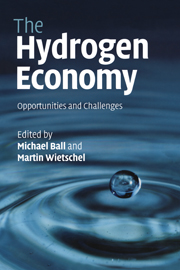Book contents
- Frontmatter
- Contents
- List of main contributors
- Preface
- Acknowledgements
- List of abbreviations
- 1 Scope of the book
- 2 Why hydrogen?
- 3 Non-renewable energy resources: fossil fuels – supply and future availability
- 4 Non-renewable energy resources: nuclear fuels
- 5 Assessment of the potentials for renewable energy sources
- 6 Carbon capture and storage
- 7 Energy-chain analysis of hydrogen and its competing alternative fuels for transport
- 8 Hydrogen today
- 9 Fundamental properties of hydrogen
- 10 Hydrogen production
- 11 Hydrogen storage
- 12 Hydrogen distribution
- 13 Key role of fuel cells
- 14 Hydrogen-infrastructure build-up in Europe
- 15 Building a hydrogen infrastructure in the USA
- 16 Hydrogen and the electricity sector
- 17 Hydrogen corridors
- 18 Macroeconomic impacts of hydrogen
- 19 Sustainable transport visions: the role of hydrogen and fuel-cell vehicle technologies
- 20 Energy-efficient solutions needed – paving the way for hydrogen
- 21 The future of hydrogen – opportunities and challenges
- Further reading
- Index
- References
17 - Hydrogen corridors
Published online by Cambridge University Press: 22 January 2010
- Frontmatter
- Contents
- List of main contributors
- Preface
- Acknowledgements
- List of abbreviations
- 1 Scope of the book
- 2 Why hydrogen?
- 3 Non-renewable energy resources: fossil fuels – supply and future availability
- 4 Non-renewable energy resources: nuclear fuels
- 5 Assessment of the potentials for renewable energy sources
- 6 Carbon capture and storage
- 7 Energy-chain analysis of hydrogen and its competing alternative fuels for transport
- 8 Hydrogen today
- 9 Fundamental properties of hydrogen
- 10 Hydrogen production
- 11 Hydrogen storage
- 12 Hydrogen distribution
- 13 Key role of fuel cells
- 14 Hydrogen-infrastructure build-up in Europe
- 15 Building a hydrogen infrastructure in the USA
- 16 Hydrogen and the electricity sector
- 17 Hydrogen corridors
- 18 Macroeconomic impacts of hydrogen
- 19 Sustainable transport visions: the role of hydrogen and fuel-cell vehicle technologies
- 20 Energy-efficient solutions needed – paving the way for hydrogen
- 21 The future of hydrogen – opportunities and challenges
- Further reading
- Index
- References
Summary
The discussions in Chapters 3 and 5 have shown that conventional fossil as well as renewable resources are limited and that strong competitions between the future uses of the primary energy carriers exist. In Chapter 16 the necessity of long-term transport of hydrogen for such reasons as relevant geographical distances between location of resources and demand centres was discussed in detail in the geographical scope of a country. Now, this chapter deals with questions of import or export of hydrogen. While import strategies – or energy corridors – are common and well known for natural gas, oil and electricity, the idea of hydrogen corridors is foreign to many people.
Such hydrogen corridors offer, among other things, in the long term the possibility of coping with the energy resource limitations for hydrogen production and improving energy supply security. Domestic energy resources are limited within the most industrial countries and, therefore, one open research question is whether it is a sustainable option to produce hydrogen outside and import it.
What is a hydrogen corridor?
In the following, we understand as a hydrogen corridor the import-based supply chain of hydrogen, including production in the country of origin and transport to the border of the country of destination. For a better understanding of what is a hydrogen corridor and which elements can be involved, an example for a concept of a hydrogen corridor between Iceland and the EU25 is shown in Fig. 17.1. Here, the principle is as follows.
- Type
- Chapter
- Information
- The Hydrogen EconomyOpportunities and Challenges, pp. 507 - 528Publisher: Cambridge University PressPrint publication year: 2009



